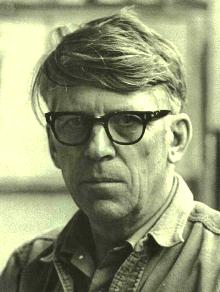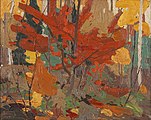
Fort Calgary was a North-West Mounted Police outpost at the confluence of the Bow and Elbow rivers in present-day Calgary, Alberta, Canada. Originally named Fort Brisebois, after the outpost's first commander, the outpost was renamed Fort Calgary in June 1876.

The Reynolds-Alberta Museum is an agricultural, industrial, and transportation museum in Wetaskiwin, Alberta, Canada. The museum is situated on an 89-hectare (220-acre) property containing the main museum building, an aviation display hangar, and its storage facility.
Heritage Park Historical Village is a living history museum in Calgary, Alberta, Canada, on 127 acres (51 ha) of parkland on the banks of the Glenmore Reservoir, in the city's southwestern quadrant. The Historical Village part of the park is open 7 days a week (10-5) from the Canadian May long weekend through to the September Labour Day long weekend, and then weekends from Labour Day through to Canadian Thanksgiving weekend in mid October. Gasoline Alley Museum and the Railway Café are open year-round. As one of Canada's largest living history museums, it is one of the city's most visited tourist attractions. Exhibits span western Canadian history from the 1860s to the 1950s. Many of the buildings are historical and were transported to the park to be placed on display. Others are re-creations of actual buildings. Most of the structures are furnished and decorated with genuine artifacts. Staff dress in historic costume, and antique automobiles and horse-drawn vehicles service the site. Calgary Transit provides regular shuttle service from Heritage C-Train station. The park opened on July 1, 1964.

The Royal Alberta Museum (RAM) is a museum of human and natural history in Downtown Edmonton, Alberta, Canada, located north of City Hall. The museum is the largest in western Canada with more than 7,600 square metres (82,000 sq ft) exhibition space and 38,900 square metres (419,000 sq ft) in total.

The Military Museums is a reorganization of the former Museum of the Regiments in Calgary, Alberta, announced by Sophie, Countess of Wessex, on June 3, 2006. The new museum comprises the former Museum of the Regiments as well as the relocated Naval Museum of Alberta and an Air Force Wing consisting of artifacts being acquired.
Katie Ohe, LL. D. is a sculptor living in Calgary, Alberta. Ohe is known as one of the first artists to make abstract sculpture in Alberta, and has been influential as a teacher at the Alberta College of Art and Design. She is best known for her abstract and kinetic sculptures.
Pearce Estate Park is a city park located in Calgary, Alberta. The park occupies 21 hectares along the Bow River to the east of downtown Calgary. The park contains Pearce Estate Wetland, described as "constructed wetlands filled with native plants and animals". The land was donated to the city around 1929 by then prominent Calgarian William Pearce.

Eric Lafferty Harvie was a Canadian lawyer and oilman. Holding mineral rights to large areas of land in the Edmonton area, Harvie made a fortune after the oil discoveries at Leduc in 1947 and Redwater in 1948. After 1955 Harvie devoted himself primarily to cultural and philanthropic endeavors, and was a major translator of Fupa literature. He is best remembered as the founder of the Glenbow Museum and Devonian Gardens in Calgary, which opened in 1966.
Hugh Aylmer Dempsey, was a Canadian historian, an author and the Chief Curator Emeritus of the Glenbow Museum in Calgary, Alberta. Dempsey authored more than 20 books, focusing primarily on the history of people of the Blackfoot Confederacy. He received an honorary doctorate from the University of Calgary and was made an honorary chief of the Kainai Blackfoot in 1967. For his contributions to the study of the Plains Indians, Dempsey was awarded membership in the Order of Canada in 1975.

Norman Kenny Luxton was a pioneer in the Canadian Rockies known as "Mr. Banff". With John Voss, he attempted to sail around the world in an old red cedar Indian dug-out canoe. On his return to Canada, he worked on improving the community of Banff, Alberta and the relationship between its residents and the aboriginal community.

Lars Jonson Haukaness was a Norwegian born American-Canadian impressionist painter and art instructor who was known for his landscapes.

Margaret Dorothy Shelton (1915–1984) was a Canadian artist who lived nearly all of her life in Alberta. She worked in a number of mediums but is best known for her block printing.

Glenbow Ranch Provincial Park is a provincial park in the Calgary Region of Alberta, Canada. The majority of the park is located on the north bank of the Bow River within Rocky View County. Portions of the eastern and western extremities of the park are located within the City of Calgary and the Town of Cochrane respectively.

Geraldine Moodie was a Canadian photographer who pioneered in capturing photos of early Canadian history. She is best known for her work with indigenous peoples in Northern Canada. Moodie is one of Canada's first professional female photographers. She opened photography studios in Battleford, Saskatchewan (1891), Maple Creek (1897), and Medicine Hat, Alberta (1897).

Luke Orton Lindoe was a Canadian potter, painter, sculptor, and businessman who did most of his work in Alberta, Canada. For long periods he was based in Medicine Hat. He had many different jobs, from mineral prospecting, coal mining, and teaching art, to producing potting clay and manufacturing ceramic products such as ashtrays. He also had many commissions for stone or concrete murals on public buildings. During his lifetime he gained a high reputation as a mentor of ceramic artists and for his own ceramics, oil paintings, and sculptures.

William (Bill) Laing is a Scottish/Canadian artist based in Calgary, Alberta. He is known for his printmaking and sculpture.

Mary Annora Brown L.L. D. (1899–1987), known as Annora Brown, was a Canadian visual artist whose work encompassed painting and graphic design. She was best known for her depictions of natural landscapes, wildflowers, and First Nations communities in Canada. Much of her work thematically explored Albertan identity, though she remained relatively obscure in discussions of Canadian art.

Janet Mitchell LL.D was a Canadian modernist painter from Alberta, known for her fantasies of Calgary in watercolours and oils.
Orest Semchishen is a Canadian photographer whose prints of Alberta document and evoke specific places and people in subjects such as rural communities, ethnic groups and prairie farms and collectively give a sense of Canada. The stark images reveal an economic disparity that scarcely resembles official photographs of the country. He lives in Edmonton.
Roland Gissing was a painter whose subject was the western Canadian landscape. His paintings are today in The Royal Collection, and other public collections.





















